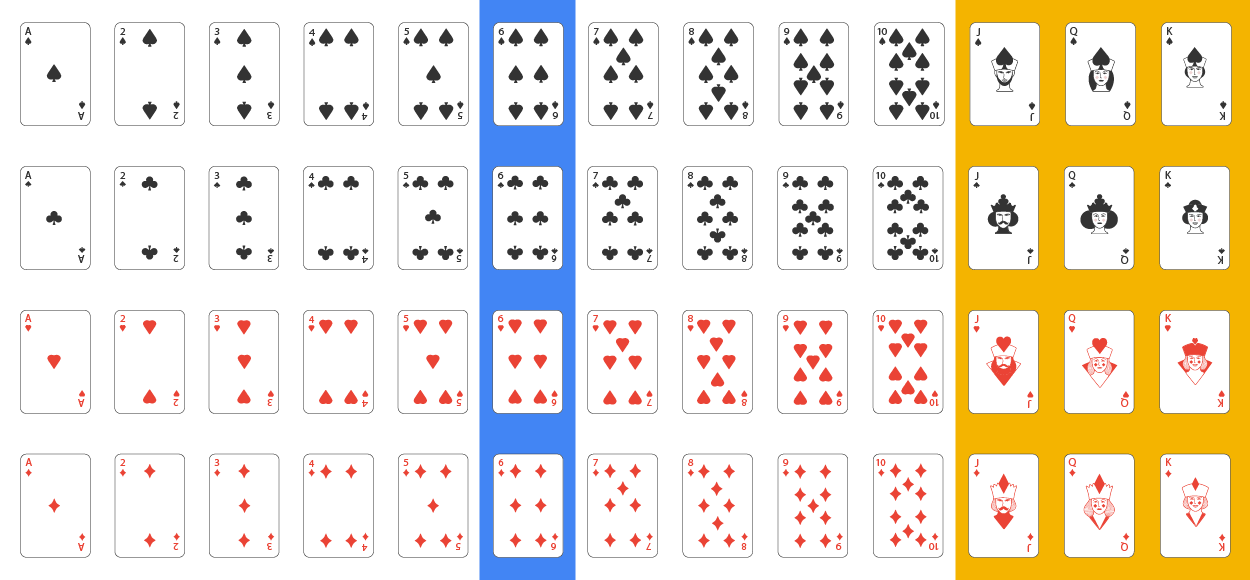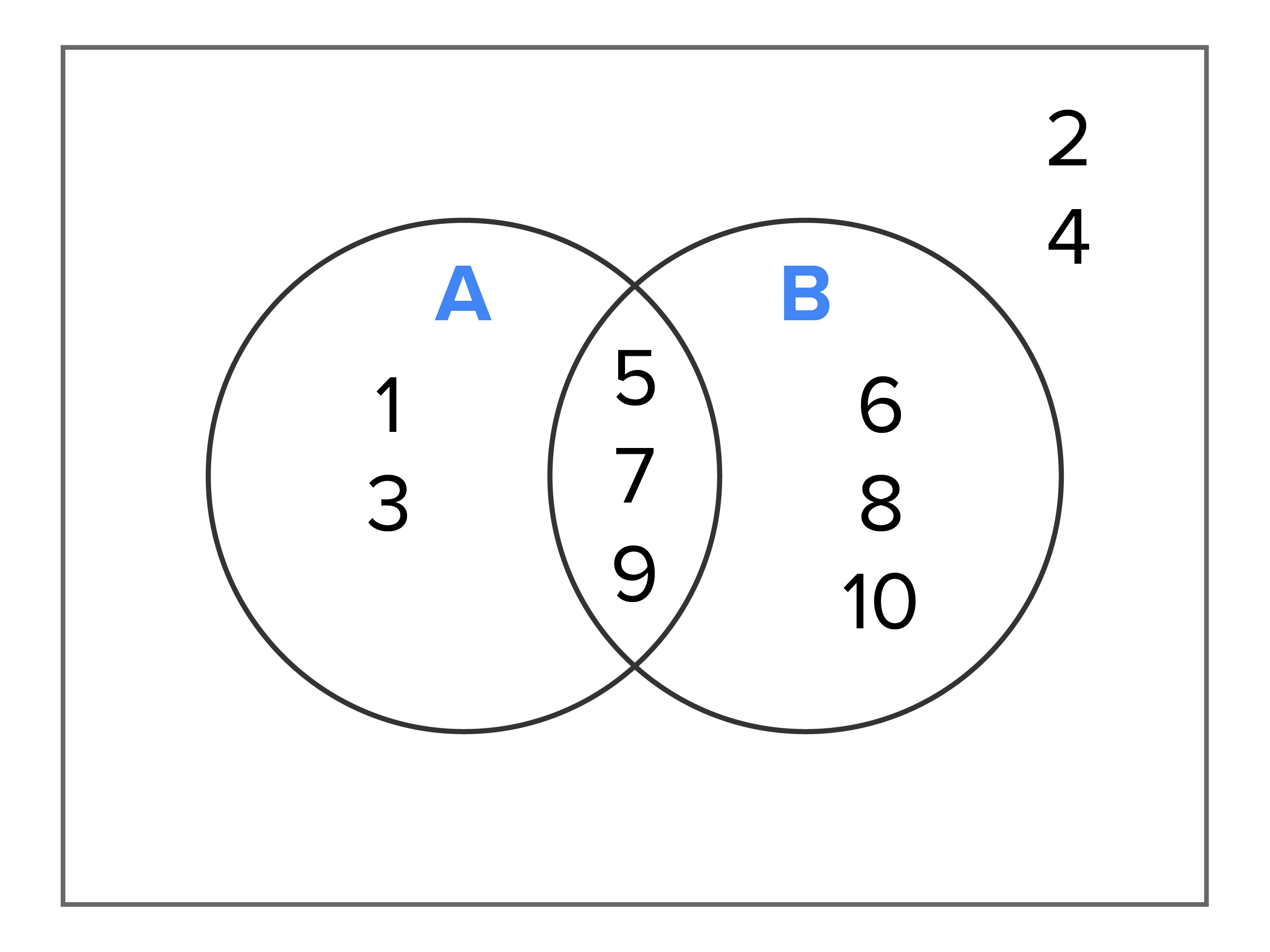This tutorial will explain overlapping and non-overlapping events. You'll also have an opportunity to analyze your productivity skill. Specifically, this lesson will cover:
1. Standard Deck of Cards
Before learning more about probability, let’s review a standard deck of cards. There are a total of 52 cards in a deck. The 52 cards in the deck look like this:

-
Colors: There are two different color card patterns within the deck of cards: red and black. Half of the deck is red and half of the deck is black.
-
Suits: There are 4 suits in the deck of cards. This means there are four different patterns on the cards: spades (♠), hearts (♡), diamonds (♢) and clubs (♣). Each suit has 13 cards. Red color cards are hearts and diamonds. Black color cards are spades and clubs.
-
Face Cards: Each of the four suits have three “face” cards. These are the cards that have pictures of people’s faces on them. The three face cards for each suit are the Jack (J), Queen (Q), and King (K). For example, there are 4 Jacks in a deck of cards: a Jack of spades, a Jack of hearts, a Jack of diamonds and a Jack of clubs.
-
Number cards: There are ten cards in each suit that are not face cards. These are the Ace (A) and cards numbered from 2 through 10.
2. Overlapping Events
Overlapping events refers to two events that can both occur at the same time. Let's look at an example.
In picking a card from a deck, you might pick a six, or you might pick a heart. You might also pick a six of hearts, which has both the characteristics of being a six and a heart.

The events six and heart are considered overlapping events. The event six has four outcomes. The event heart has 13 outcomes. There's at least one outcome that's the same for both of them. The event six and heart can happen at the same time if you pick the six of hearts.
-
- Overlapping Events
- Two events that can occur in a single trial of a chance experiment.
3. Non-Overlapping Events
Conversely, non-overlapping events are events that can't happen at the same time. The events six and face card, for example, are non-overlapping. If you pick a six, it is not possible to also be picking a face card, and vice versa—if you're picking a face card, you're not picking a six.

-
Disjoint and mutually exclusive are two other terms that are used for non-overlapping events. These are both very common terms.
-
- Non-Overlapping Events
- Two events that cannot both occur in a single trial of a chance experiment. If one event occurs, the other event must not also occur.
4. Using a Venn Diagram
You can show either overlap or non-overlap in a Venn diagram.
-
EXAMPLE
Suppose you have these two events from spinning the following spinner:
- Event A is landing on an odd number.
- Event B is landing on a number larger than 4.

If you're landing on an odd number, some outcomes are also larger than 4. In a Venn diagram, you show those as two circles that overlap.
|
Venn Diagram for Overlapping Events
|
|---|
|
Event A: Landing on "Odd"
|
Event B: Landing on "Larger Than 4"
|

|
-
Suppose you have these two events from spinning the same spinner above:
- Event A is landing on a prime number.
- Event B is landing on an even number.
How would you create a Venn diagram showing the outcomes of the two events?

Recall that a prime number is a number that is only divisible by itself and 1. There are no other smaller numbers that divide evenly into a prime number. The prime numbers less than 10 are 1, 3, 5, and 7. But, notice that 2 is a prime number and it is also an even number. So, these are overlapping events.
|
Venn Diagram for Overlapping Events
|
|---|
|
Event A: Landing on "Prime"
|
Event B: Landing on "Even"
|

|
-
EXAMPLE
Suppose you have these two events from rolling a die:
- Event A is rolling an even.
- Event B is rolling a five.
|
Venn Diagram for Non-Overlapping Events
|
|---|
|
Event A: Rolling "Even"
|
Event B: Rolling "5"
|

|
If you're rolling an even, you're certainly not rolling a five, and if you're rolling a five, you're certainly not rolling an even number. In a Venn diagram, you show those as two circles that do not overlap.
Non-overlapping events can't be independent. With independent events, knowing what happened with event A doesn't change the probability that B will occur, whereas with disjoint or mutually exclusive events, knowing that event A occurred changes the probability of B. In fact, we know that the occurrence of event A changes the probability of B: it changes it to zero because B can't happen if A has occurred.
Being able to organize your thoughts and strategize are important aspects of your productivity skill, and Venn diagrams are a helpful way to keep things straight. Can you think of any scenarios in your personal or work life where using Venn diagrams might aid your planning ability or speed up calculations?
You began this lesson by reviewing a standard deck of cards, noting that it has two different color card patterns (red and black), 4 suits (spades ♠, hearts ♡, diamonds ♢, and clubs); each of the four suits have three “face” cards (Jack, Queen, and King), and there are ten cards in each suit that are not face cards (the Ace and cards numbered from 2 through 10). You learned that overlapping events are two events that can both occur at the same time, while non-overlapping events are events that can't happen at the same time (also known as disjoint events or mutually exclusive events). This means that if one happens, then the other one doesn't happen. You also learned that you can show either overlap or non-overlap using a Venn diagram.
Best of luck in your learning!





